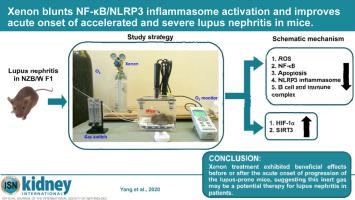Kidney International ( IF 14.8 ) Pub Date : 2020-04-06 , DOI: 10.1016/j.kint.2020.02.033 Shin-Ruen Yang , Kuo-Feng Hua , Lichieh Julie Chu , Yeu-Kuang Hwu , Shun-Min Yang , Chung-Yao Wu , Tsai-Jung Lin , Jui-Chun Weng , Hailin Zhao , Wan-Han Hsu , Feng-Cheng Liu , Wen-Jinn Liaw , Daqing Ma , Shuk-Man Ka , Ann Chen

|
Xenon, an inert anesthetic gas, is increasingly recognized to possess desirable properties including cytoprotective and anti-inflammatory effects. Here we evaluated the effects of xenon on the progression of lupus nephritis (LN) in a mouse model. A two hour exposure of either 70% xenon or 70% nitrogen balanced with oxygen was administered daily for five weeks to female NZB/W F1 mice that had been induced to develop accelerated and severe LN. Xenon treatment improved kidney function and renal histology, and decreased the renal expression of neutrophil chemoattractants, thereby attenuating glomerular neutrophil infiltration. The effects of xenon were mediated primarily by deceasing serum levels of anti-double stranded DNA autoantibody, inhibiting reactive oxygen species production, NF-κB/NLRP3 inflammasome activation, ICAM-1 expression, glomerular deposition of IgG and C3 and apoptosis, in the kidney; and enhancing renal hypoxia inducible factor 1-α expression. Proteomic analysis revealed that the treatment with xenon downregulated renal NLRP3 inflammasome-mediated cellular signaling. Similarly, xenon was effective in improving renal pathology and function in a spontaneous LN model in female NZB/W F1 mice. Thus, xenon may have a therapeutic role in treating LN but further studies are warranted to determine applicability to patients.
中文翻译:

Xenon 减弱了 NF-κB/NLRP3 炎症小体的激活,并改善了小鼠加速和严重狼疮性肾炎的急性发作。
氙气是一种惰性麻醉气体,越来越多地被认为具有理想的特性,包括细胞保护和抗炎作用。在这里,我们在小鼠模型中评估了氙气对狼疮肾炎 (LN) 进展的影响。对已被诱导发展为加速和严重 LN 的雌性 NZB/W F1 小鼠每天给予 2 小时暴露于 70% 氙气或 70% 与氧气平衡的氮,持续 5 周。氙气治疗改善了肾功能和肾组织学,并降低了中性粒细胞趋化因子的肾表达,从而减弱了肾小球中性粒细胞浸润。氙的作用主要通过降低抗双链 DNA 自身抗体的血清水平、抑制活性氧的产生、NF-κB/NLRP3 炎性体激活、ICAM-1 表达、肾脏中 IgG 和 C3 的肾小球沉积和细胞凋亡;并增强肾缺氧诱导因子 1-α 的表达。蛋白质组学分析显示,氙治疗下调肾脏 NLRP3 炎性体介导的细胞信号传导。同样,氙在改善雌性 NZB/W F1 小鼠自发 LN 模型中的肾脏病理学和功能方面是有效的。因此,氙在治疗 LN 中可能具有治疗作用,但需要进一步研究以确定对患者的适用性。氙可有效改善雌性 NZB/W F1 小鼠自发 LN 模型的肾脏病理和功能。因此,氙在治疗 LN 中可能具有治疗作用,但需要进一步研究以确定对患者的适用性。氙可有效改善雌性 NZB/W F1 小鼠自发 LN 模型的肾脏病理和功能。因此,氙在治疗 LN 中可能具有治疗作用,但需要进一步研究以确定对患者的适用性。











































 京公网安备 11010802027423号
京公网安备 11010802027423号